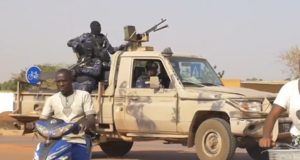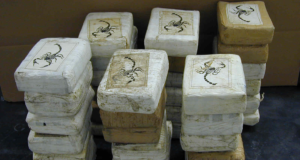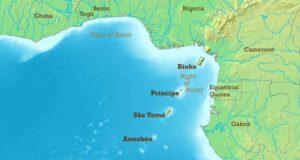The ongoing feud between Kiir and Machar intensified over the coming months and in December last year resulted in what Kiir claimed was an attempted coup from Machar when members of the presidential guard were attacked on the15 December 2013. Machar denies that he had anything to do with the incident, but nonetheless, full-scale conflict rapidly developed and Machar was quick to take leadership of the armed rebellion.
 Since the conflict broke out, the effect of the war on civilians in the region has been devastating. The fighting was originally confined to the capital Juba, but has spread to the wider states of Jonglei, Unity and Upper Nile and even further. Latest figures from the UN suggest that more than 10,000 have been killed and over 870,000 have been displaced internally to UN shelters and externally to Kenya, Sudan and Ethiopia. The image to the left shows the full extent of the displacement. In the city of Bor they are running out of places to bury the dead, with many being left to decompose where they were killed. On the 24 December the UN Security Council authorised an increase of the number of peacekeepers in South Sudan from 7,000 to 12,500 and has released $15m in humanitarian aid, but this has come too late for a vast majority of the population affected by the conflict. Overcrowding in shelters is becoming a serious issue, with reports of one centre holding more than 32,500 people despite being only designed for 400.[8] Human rights abuses are widespread, but the full extent of these are yet unknown.
Since the conflict broke out, the effect of the war on civilians in the region has been devastating. The fighting was originally confined to the capital Juba, but has spread to the wider states of Jonglei, Unity and Upper Nile and even further. Latest figures from the UN suggest that more than 10,000 have been killed and over 870,000 have been displaced internally to UN shelters and externally to Kenya, Sudan and Ethiopia. The image to the left shows the full extent of the displacement. In the city of Bor they are running out of places to bury the dead, with many being left to decompose where they were killed. On the 24 December the UN Security Council authorised an increase of the number of peacekeepers in South Sudan from 7,000 to 12,500 and has released $15m in humanitarian aid, but this has come too late for a vast majority of the population affected by the conflict. Overcrowding in shelters is becoming a serious issue, with reports of one centre holding more than 32,500 people despite being only designed for 400.[8] Human rights abuses are widespread, but the full extent of these are yet unknown.
In addition to the obvious repercussions from the war, many are at risk of starvation through the conflict disrupting markets and trade and supply routes.[9] Even before the conflict broke out, 4.4m out of a total population of 11m were food insecure and the current situation has aggravated this even further. The World Food Programme have warned that the situation could worsen even further than it stands as their current preparations for upcoming rainy season has been disrupted, and at least 10% of its food stocks have been looted. In 2010 it was estimated that 28% of children under the age of 5 in South Sudan were undernourished[10]; this figure is likely to rise considerably if this conflict continues.
 What began as an outright political battle has, in a short space of time, morphed into an ethnic conflict. There are over 200 ethnic groups within South Sudan (see image to right), with Dinka making up the biggest group and Nuer the second largest group, so it is easy to see how the conflict could become ethnicised. With Kiir being Dinka and Machar Nuer it has pitched the two ethnic groups against one another and there are fears among some of the Nuer population that they could become victims of ethnic cleansing. At a UN base in Juba, there are more than 17,000 people seeking refuge, most of them Nuer. Despite the conditions being poor and the space cramped, most feel safer there than they do on the streets of Juba, where there are reports that Nuer are being killed in revenge attacks.[11] The UN Assistant Secretary General for Human Rights Ivan Simonovic visited South Sudan in January and saw this situation first hand: “Truth is becoming ethnicised.”
What began as an outright political battle has, in a short space of time, morphed into an ethnic conflict. There are over 200 ethnic groups within South Sudan (see image to right), with Dinka making up the biggest group and Nuer the second largest group, so it is easy to see how the conflict could become ethnicised. With Kiir being Dinka and Machar Nuer it has pitched the two ethnic groups against one another and there are fears among some of the Nuer population that they could become victims of ethnic cleansing. At a UN base in Juba, there are more than 17,000 people seeking refuge, most of them Nuer. Despite the conditions being poor and the space cramped, most feel safer there than they do on the streets of Juba, where there are reports that Nuer are being killed in revenge attacks.[11] The UN Assistant Secretary General for Human Rights Ivan Simonovic visited South Sudan in January and saw this situation first hand: “Truth is becoming ethnicised.”
A potential resolution for the conflict seemed a possibility when it was announced at the end of December that peace talks would be commencing between the two factions in the Ethiopian capital of Addis Ababa. These peace talks began at the start of January and were largely at a stalemate over disagreement about what to do with the 11 former government members that are being detained. However, on the 23 January a ceasefire was signed with the agreement that fighting would come to an end within 24 hours. Upon signing this the South Sudanese government was sceptical that the opposition would be able to control the militias and indeed it appears that they were correct. Less than a few days into the ceasefire, there were already reports that fighting had reignited, with the ceasefire being violated by both sides.
With the peace talks having recommenced on the 11 February, the two sides, with the support of the international community, must attempt to agree on a comprehensive and long term solution for ending the conflict, or risk South Sudan becoming a failed state. The government has thus far failed to deliver the promises they made upon independence from Sudan – since independence, 38% of oil revenue (the biggest revenue source in the country) has been spent on military and security services, whilst only 10% has been spent on infrastructure and 7% on education.[12] In addition to this, Kiir has been accused of becoming authoritarian, which led to a foreign diplomat commenting, “There is a danger that this country that fought so hard for its liberty is going to end up resembling the country it fought against.”12 It is clear that unless the underlying political problems are addressed, lasting peace will not be achieved and the conflict could remain indefinitely. The United States Institute of Peace suggested a number of proposals in a peace brief that could help South Sudan on the path to a more stable future.[13] The UN and other key members of the international community that support independence have a responsibility to help rebuild the country, be it through aid or helping draft a new constitution, with which the people should also be heavily involved. A national truth and reconciliation process akin to that seen in South Africa post-apartheid would greatly benefit the country going into a hopefully more stable and prosperous future. Only time will tell if the ceasefire will prove to be successful – although current reports indicate that it has failed already – or whether the current round of peace talks will bring a solution to the protracted political conflicts and economic disparities that the peoples of South Sudan have had to endure for so many years.
[1] R. O. Collins, Civil Wars and Revolution in the Sudan: Essays on the Sudan, Southern Sudan (California: Tsehai Publishers, 2005).
[2] L. Akol, SPLA/SPLM: The Nasir Declaration (Self published through iUniverse inc, 2003).
[3] D. Feysus, Playing Different Games: The Paradox of Anywaa and Nuer Identification Strategies in the Gambella Region, Ethiopia (Oxford: Berghahn Books, 2011), 206-207.
[4] The London Evening Post, ‘Riek Machar in tears as he admits to 1991 Bor massacres’, 16 August 2011.
[5] The Background to Sudan’s Comprehensive Peace Agreement, United Nations Mission in Sudan, http://unmis.unmissions.org/Default.aspx?tabid=515
[6] BBC World News Africa, South Sudan President Salva Kiir in profile, http://www.bbc.co.uk/news/world-africa-12107760, 23 December 2013.
[7] BBC News Africa, ‘South Sudan’s Salva Kiir Sacks Cabinet,’ http://www.bbc.co.uk/news/world-africa-23428557, 24 July 2013.
[8] UN News Centre ‘Numbers of South Sudanese uprooted by conflict surges to over 400,000, UN reports’ 14 January 2014 http://www.un.org/apps/news/story.asp?NewsID=46926&Cr=south+sudan&Cr1=#.UtaoEv0dAds
[9]UN News Centre ‘Hunger looms in South Sudan as fighting threatens to disrupt agriculture, UN warns’ 12 January 2014 http://www.un.org/apps/news/story.asp?NewsID=46919&Cr=South+Sudan&Cr1=#.Utap9v0dAds
[10] Source: Sudan Household Health Survey 2010
[11] The Telegraph, ‘Refugees in their own country – thousands cram into UN base as South Sudan’s civil war rages’ 10 January 2014 http://www.telegraph.co.uk/news/worldnews/africaandindianocean/south-sudan/10564565/Refugees-in-their-own-country-thousands-cram-into-UN-base-as-South-Sudans-civil-war-rages.html
[12] The Guardian, ‘South Sudan: The Death of a Dream’, 20January 2014 http://www.theguardian.com/world/2014/jan/20/south-sudan-death-of-a-dream
[13] United States Institute of Peace, Peace Brief 164: Crisis and Opportunity in South Sudan, 8 January 2014.
Elizabeth Laruni is contactable at:
Elizabeth.Laruni@hscentre.org
Michelle McKenna is contactable at:
Michelle.McKenna@hscentre.org
Please cite this article as:
Laruni, E., McKenna, M. (2014) ‘Conflict in South Sudan: Civil War as a Political Weapon’. Human Security Centre, Human Rights and Conflict Resolution, Issue 1, No. 5.
 Human Security Centre Human Rights and International Security Research
Human Security Centre Human Rights and International Security Research



